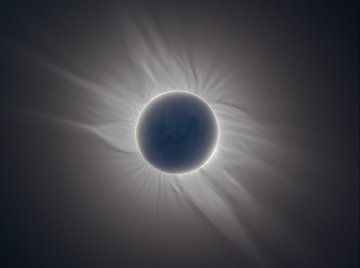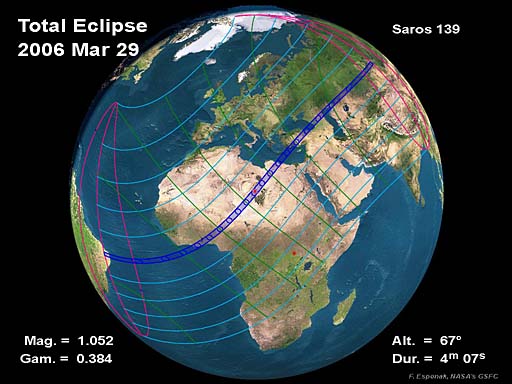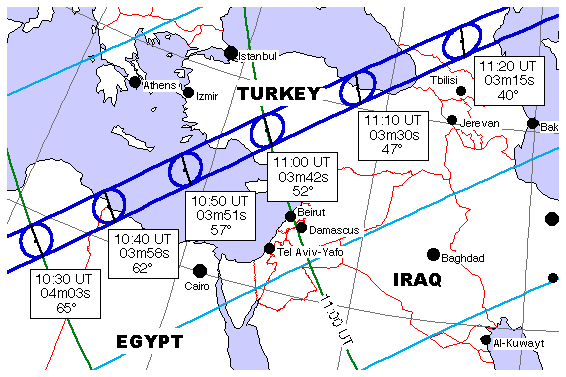A total eclipse of the Sun is just round the corner. It
is due on March 29, 2006. Earth dwellers have been observing a total solar eclipse,
an extremely interesting astronomical phenomenon, for a few thousand
years. However, scientists became capable of explaining the essence of
solar eclipse just recently.
Still, modern civilized people, no matter how
well-educated they may be, are likely to be filled with awe when suddenly
he sees the whole world being plunged into darkness at midday and a “black hole” with
a pearly otherworldly corona eats away the Sun.
All world religions pay special attention to the
description of an eclipse. Normally, it would comprise a lucid god of the
Sun fighting against the forces of Evil e.g. devils, demons, and a horrid
dragon. Our
ancestors would help the Sun overcome a terrifying black shadow by making
a lot of noise – they would beat the drums and blow the horns, they would
shake the rattles and fire their weapons at the demons. And the Sun would
always gain the victory.
Actually, it is wrong to use the term eclipse with
regard to the phenomenon of the Moon passing in front of the Sun. In
precise scientific terms, it is an occultation. An eclipse
takes place when an object passes into the shadow cast by another
object. When the Sun is completely obscured by the Moon, the phenomenon is
called a total eclipse. An annular eclipse occurs when the
Sun and the Moon are exactly in line. When the Sun and the Moon are not
exactly in line, and the Moon obscures only part of the Sun, it is called
a partial eclipse. The generic term for a total, an annular and
hybrid eclipse is a central eclipse. The reason why some solar
eclipses are total and others are annular or partial lies in the
elliptical nature of the Moon. The Moon’s orbit
around the Earth is inclined at an angle of 5.2 degrees to the plane of
the Earth’s orbit around the Sun (the ecliptic). Because of this,
the Moon will only pass above or below the Sun at the time of a New Moon.
A solar eclipse can occur only when the New Moon is close to the so-called
nodes i.e. the points where the Moon’s orbit crosses the ecliptic.
The Moon’s orbit is also elliptical – the distance
between the Moon and Earth can vary by approximately 6% from the average
value. In other words, the apparent size of the Moon is sometimes larger
or smaller than average, and it is this effect that leads to the
difference between total and annular eclipses. The Sun lies about 400
times as far as does the Moon, and the Sun is also about 400 times the
diameter of the Moon. As seen from Earth, the Sun and the Moon appear to
be about the same size in the sky, around ½ of a degree in angular
measure.
A total solar eclipse occurs when the Moon is at or near
perigee or the closest point in the orbit and the Moon appears
large enough to cover the bright disk, photosphere, of the Sun
completely. In case a solar eclipse occurs when a solar eclipse when the
Moon is at or near apogee or the further point, and the Moon
appears smaller, the therefore it can not cover the Sun completely. In
that case, at the time of greatest eclipse a thin annulus of the
brilliant Sun remains uncovered. Slightly more annular eclipses than the
total ones occur because the average Moon lies too far away from Earth to
cover the Sun completely.
People living in Russia have not yet had a chance of
observing a total solar eclipse in the 21st century. The last
total eclipse of the Sun could be observed only in the northern regions of
the European part of Russia on March 9, 1997. A solar eclipse similar to
the one due on March 29 this year took place 25 years ago, in 1981. The
next solar eclipse will be visible in the European part of Russia only in
2061.
During a solar eclipse, the dark grey region to the right
of the Moon is the umbra. The term designates the Sun completely
obscured by the Sun. The small area where the umbra touches the Earth’s
surface is where a total eclipse can be seen. The larger area is called
the penumbra, in which a partial eclipse will be seen. During a
central eclipse, the Moon’s umbra moves rapidly from the west to east
across the Earth. The Earth is also rotating from west to east but the
umbra always moves faster than any given point on the Earth’s surface, so
it almost always appears to move in a roughly west-east direction across a
map of the Earth (there are some rare exceptions of this which can occur
during an eclipse of the midnight sun in Arctic or Antarctic regions).
The width of the track of a central eclipse varies
according to the relative apparent diameters of the Sun and Moon. In the
most favorable circumstances, when a total eclipse occurs very close to
perigee, the track can be over 250 km wide and the duration of totality
may be over 7 minutes. Outside of the central track, a partial eclipse can
usually be seen over a larger area of the Earth.
This time around, on March 29th, 2006, the
eclipse begins at dawn. The shadow will fall on to the Earth in the
tropical forests of eastern Brazil near the Atlantic coastline. The umbra
will move at a very high speed. Totality is expected to last only one
minute over that area. After crossing the Atlantic Ocean, the umbra will
start covering Africa’s shoreline, moving over Ghana to Togo to Benin and
Nigeria. The umbra will reach the Sahara at the junction of the state
borders of Nigeria, Chad and Libya. Totality will reach its peak over the
region – 4 minutes 6 seconds. After passing over the Mediterranean and
Turkey, the umbra will move across the eastern part of the Black Sea to
cover the area over the entire Central Caucasus. Then the umbra will move
across Elbrus and cover the plains of southern Russia. The shadow will
reenter the Russian territory at the foothills of the Altai mountain
range. Totality in that area will last 2 minutes only. In another 15
minutes the eclipse will finally shift to Mongolia where it will finally
end at sundown.
Apart from being a rare a unique sight, an eclipse is a
very impressive phenomenon to observe. According to those who have been in
luck and saw an eclipse, it is something worth seeing at least once in a
lifetime.
Izvestia
Nauki


